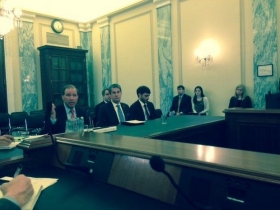This post was authored by HEFN Program Director Jeff Wise.
Advocates and funders have been investing in an overhaul of U.S. chemicals policy for over a decade, but the next few months will be critical.
The next chapter in the story of reforming America’s flawed toxic chemicals law—the 1976 Toxic Substances Control Act (TSCA)—is unfolding now. Full of the twists, turns, and drama of a House of Cards episode, it’s hard to know how it’s all going to end. But it will end, likely early this summer, either in a successor to TSCA or the status quo.
Concerned about the lack of protection Americans currently have from many dangerous and untested chemicals, HEFN members and their grantees have been engaged in a multi-year marathon effort—including research, stakeholder engagement, and market and policy campaigns—to press industry and policymakers toward reform.

The new focus is a Senate bill, the Frank R. Lautenberg Chemical Safety for the 21st Century Act, with Sen. Vitter (R-LA) and Sen. Udall (D-NM) as lead cosponsors. Environmental health advocates had pressed for improvements to the last Congress’s Lautenberg-Vitter bill and have praised some improved elements of the new bill. But most advocates are concerned that the Vitter-Udall bill takes several steps back in other areas and on balance would actually be less protective than current law.
The Senate bill would fix some major flaws in TSCA by evaluating chemicals against a health-based standard, requiring standards to protect vulnerable subpopulations like kids, and laying out an actual timetable for chemical review—all welcome and long overdue reforms. But most environmental and health advocates say that the current bill’s negatives outweigh the positives:
- Slow timetable. The required chemicals assessment timetable—25 chemicals in five years—represents just a slight increase in the pace of current assessments.
- Insufficient funding for testing. The fees levied on industry for testing are minimal and would be insufficient to support a robust testing program at the Environmental Protection Agency (EPA).
- A free pass for many chemicals. A new and ill-defined category of “low priority” chemicals has the potential to give chemicals a free pass through the regulatory system with no public scrutiny or review.
- Inability to regulate products. It would be more difficult than under current law for EPA to regulate chemicals in products. Even if a chemical flunks its safety assessment, EPA couldn’t impose limitations on a product that contains the chemical unless it is able to prove that the product is a “significant source of exposure” for the chemical—a high burden to meet.
- State preemption. Under current law, states are free to regulate a chemical until EPA actually imposes its own restrictions on the chemical. The bill would move up the date of preemption to the point when EPA just puts a chemical on its list to review. Since it could take as long as 7 years to review a chemical, the bill would create a “regulatory void” where no one is legally permitted to protect the public during a chemical’s review process.
These last two issues are particularly concerning for environmental health advocates as it’s widely believed that market campaigns increasing consumer pressure around chemicals in products, and state campaigns winning state policy victories, were critical factors in driving the chemical industry to the negotiating table in the first place.
The Vitter-Udall bill has substantial momentum in spite of being strongly opposed by most of the environmental and public health community as well as by state attorneys general. It’s being strongly supported by the chemical industry, several major oil companies, automobile manufacturers, several other industry associations, and the Environmental Defense Fund.
Bill supporters have managed to convince 11 Democratic senators to cosponsor the bill. This would provide the bill with a filibuster-proof majority assuming all but five Republicans and all initial sponsors support the bill enough to bring it to a vote. The Obama administration doesn’t have a position on the bill yet.
There are some promising signs that draft legislation may be introduced in the House of Representatives with more elements sought by health and environmental advocates than the Senate version. If it gains momentum, a House bill could open a pathway for keeping several of the Senate bill’s worst provisions from becoming law, including the expanded state policy preemption. Advocates talking to House staff on both sides of the aisle see potential for additional changes that could win support from environmental and public health groups.
Environmental and health advocates are gearing up now for a major campaign should it be necessary to defeat bad legislation on the Senate floor, convince Democratic senators to support a better version being offered by the House, or secure a veto by the President. By ramping up effective campaign efforts over the next few months, the goal is at least to stop any bad bills from becoming law and, if possible, leverage improved legislation that the health and environmental community can actively support.
If acceptable reforms don’t materialize this summer, advocates believe that a campaign that successfully stops bad legislation will have made it clear to industry what future bills need to include to pass. Given the growing pressure from market campaigns and legislation advancing in more than 27 states, industry may have every incentive to cut a better deal in the next Congress. Having moved chemicals policy a long way, the environmental health community is in for the long haul when it comes to fighting for stronger protections.

Jeff Wise recently joined HEFN’s staff as Program Director. Jeff comes to HEFN with deep experience in environmental policy and advocacy, including work at the White House, the National Environmental Trust, the Pew Charitable Trusts and the Alliance for Justice.

